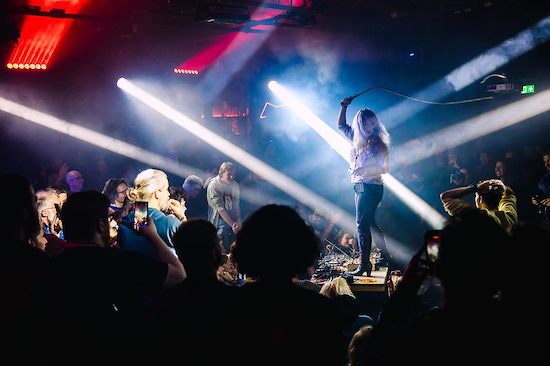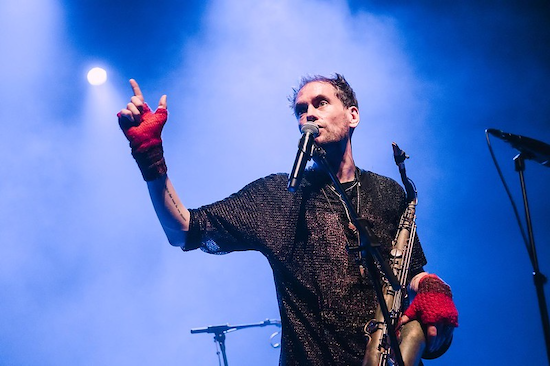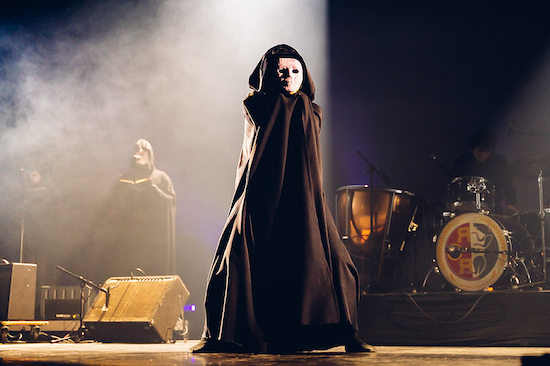Rats On Rafts, by Maarten Mooijman
Širom’s Samo Kutin drops slowly to his knees over a kitchen’s worth of pots and pans. He takes a container full of what appear to be red lentils and pours them from a height onto a smaller dish. Then, he grabs a handful at a time and throws them violently to his left and right so they strike a number of the mic’d up drums that surround him, creating a strange rippling sound. As if in anger, he casts the rest over his shoulder at the crowd. Those of us in the front row take a substantial amount of lentils direct in the face. While we process the fact, Kutin joins in the sparse and hypnotic drum pattern that his two bandmates Ana Kravanja and Iztok Koren have been unfurling in the background all the while, loose lentils jumping up like rainwater from the skin of the drum every time he beats it.
Some of the crowd at Cloud 9, the smallest of the multiple venues stuffed into Utrecht’s labyrinthine arts complex TivoliVredenburg, begin laughing. Some around me are visibly amused when Kutin spins a long flexible tube around and around above his head. Yet you can’t deny that the whirling drone he creates by doing so is totally hypnotic to hear. The band’s set encapsulates a great deal of what makes Le Guess Who? such a good festival, the sheer variety of artistic experience it delivers. The line-up’s diversity in terms of nationality, race, gender and genre is exemplary, but it is also diverse in terms of energy. There is ridiculousness and sublimity, craziness and seriousness to be found, along with everything inbetween.
Le Guess Who?’s wild side can be located most easily in EKKO, a small bar and venue ten minutes’ walk from Tivoli, which proves to be a serious hang. It’s there we are treated to a furious twin xylophone and multi-percussion attack courtesy of Mexico City’s Son Rompe Pera, and an eye-shaking gig by Colombian ritual psychonauts Romperayo during which the room feels in danger of dissolving into a thousand refracted elements under the psychicke pressure created by pinball percussion and screeching incantations. Earlier, Derya Yıldırım presents a wonderful mix of “modern-traditional” Anatolian folk music played on her bağalama, (a long-necked lute), her songs running through EKKO like a crystal clear stream. Yıldırım also gently maps out her work with the huge German-born Turkish community in speech and song. To Yıldırım, “music is more important than food”. Take note, sourdough fetishists.
At another, later hour, Evicshen does strange things to copper coils and worktables whilst piloting a course through the hinterlands of noise. There is something very sensual about her shows that also relays the giddy pleasures of this kind of music. No drybone faux-academic extemporisation here. Perhaps a common thread tying these experiences together is the sensational gig given by Tokyo rap crew, Dos Monos. Describing what goes on is hard, but I suppose I can say their set contains sound particles and aural gestures half-inched from every form of pop music and put through a blender. Akin to the sonic fallout from kicking over huge Lego statues of Johan Sebastian Bach and George Clinton. The crew’s puppyish demeanour (The Banana Splits in human form, no less) only makes things better. How did the EKKO club draw such wild mountain music out of all these acts? Its commitment to pleasure, a concomitant lack of pretence?

Evicshen by Lisanne Lentink
That’s not to say, however, that there’s no fun to be had away from EKKO. The imposing Stadsschouwburg theatre in gentil Utrecht is possibly the last place I would have imagined watching Rotterdam’s Rats On Rafts, for instance. There again they are a band with a sense of mission. And if that means a huge post-punk opera about the paranoid mind, with giant Squbbsy-style heads and Residents-style eyeballs, writhing dancers and ghostly masked choir, all in front of backdrops that nod to Spirited Away, Ingmar Bergman and Hawkwind all at once, then, phew. You have a show on your hands.
Much like their spirit animal, Rats On Rafts have always managed to adapt, even as they fight against the tide. And adding head on the scene Doortje Hiddema on keys and guitar has been a masterstroke. Suddenly their sound has taken another turn: huge and empathic, a headspace in itself. The driven nature of their songs, given considerable rhythmic substance by Mathijs Burgler, emotional punch by Fagan and colour and soul by guitarist Arnoud Verheul, is now possessed of a trickier spirit. On the night, Hiddema’s piano lines somehow add a feel of Barrett’s Floyd at their most elfin. Natasha Van Waardenburg’s bass playing is phenomenal: a robustly chugging engine steering the ship to port. Waardenburg and Hiddema’s twin vocals, countering Fagan’s barked orders, make groovy tracks like ‘Osaka’ and ‘Tokyo Music Experience’ sky-high experiences. They’re not playing this iteration of their set again. A tragedy for humankind.
As the festival’s main hub, the five venues contained within Tivoli have more of an air of a ‘traditional’ festival than those scattered around the city like EKKO, Stadsschouwburg, late-night clubs BASIS and WAS. or the distant and dingy De Helling, where Gnod are left to their own devious devices to program a Saturday of shows that sees their affiliated projects Moundabout and Holy Scum perform before the venerable Salfordian psych-rockers themselves. Yet even within Le Guess Who?’s more stately environs there’s still plenty of madness to be found.
WaqWaq Kingdom’s performance at Cloud 9, for instance, is a riot. While contemporary artist Kalma provides live visuals, sat intently at a desktop computer, Kiki Hitomi and Shigeru Ishihara (akaDJ Scotch Egg) are both in neon, the former whirling a glittering streamer around her as she shifts in tempo in time with the latter’s restless beats, taking the set from whacked-out psych drift, all the way up to pummeling staccato overwhelm. It is all in keeping with the theme of the set, billed as ‘Glitchy Nature’, and inspired by the opulence and constant change to be found in nature. Horse Lords provide a more consistent tempo with a ferocious set of tightly wound noise to a capacity crowd at the Pandora stage, while the far larger Ronda arena gives ample space for Congolese duo KOKOKO!, whose irresistible spartan pump makes a worthy envoy for the fertile Kinshasa underground from which they hail.

WaqWaq Kingdom by Tim Van Veen
Clipping play the Ronda too, a set that is among this year’s most anticipated; after hangover-curing Oliebollen (fried dough) on Friday morning I’m told by a member of the festival’s leadership that they’ve been trying to pin down the band for years. It must surely have been worth their wait. Daveed Diggs’ sheer dexterity as a lyricist and hyperspeed flow is breathtaking in itself, but when pushed to the kind of extremes that producers William Hutson and Jonathan Snipes seek, whether with plunging bass drones or fragmented and fraying noise, it is the stuff of genuinely moving brilliance. It is worth noting that Le Guess Who?’s wider hip hop programming is particularly on point this year, with They Hate Change, Billy Woods and Zebra Katz – all curated by Clipping themselves – pushing the form to dramatic extremes of their own.
Often heaving with people both on the steep balconies and the floor (an inevitable queue to enter many venues is one of Le Guess Who?’s few downsides), the Ronda can have an intense energy when it’s at capacity, and few harness it better than Divide And Dissolve. Guitarist and clarinetist Takiaya Reed sets the band’s aims out clearly – their gargantuan, quaking instrumental noise rock is an act of anti-colonialist fury, a sound loud enough to shatter the foundations of white supremacy and bring its structures tumbling. What’s interesting, though, is just how life-affirming that sound can be when you’re on board. Reed dedicates the show to the late Mimi Parker of Low, with whom Divide And Dissolve toured (“This one’s for Mimi” can also be found written on the boards outside the venue). “We learnt so much,” she remembers of their time together. “I learnt a lot about love, and I want to give you that love.”
The dark and crowded Ronda makes an interesting contrast with the Tivoli’s largest and most stately venue Grote Zaal, where the walls are white, the many rows of chairs a deep red, and the details varnished pine. On Saturday, it cannot be used at all due to scheduling conflicts with Utrecht’s regular classical music programme, but otherwise hosts high profile artists like The Master Musicians Of Jajouka led by Bachir Attar, whose Thursday performance makes a venerable opening to the festival proper, and a 50th anniversary celebration of the life and work of Idris Ackamoor & The Pyramids (an exhibition charting his career is also peppered among the Tivoli foyer). África Negra have the hall dancing with a joyous highlife set, and Oumou Sangare rounds off the final evening there on charismatic form. Her first ever tour manager, she recounts, was from Utrecht, and she has a great deal of affection for the city that is repaid in kind by her crowd.

Alabaster DePlume by Lisanne Lentink
On Thursday night, however, the Grote Zaal is transformed into something totally different by Sarathy Korwar, who presents his new album KALAK in incendiary fashion. The record’s title is a palindromic form of Kal, a Hindi and Urdu word meaning both yesterday and tomorrow, and the album’s indo-futurist philosophy is based around a cycle of music which moves from ancient to modern and back around again. Live, Korwar and his band articulate those themes via sequences of spoken-word, soul-shaking lattices of percussion (he is a generationally talented drummer), and blistering, mazing squalls of keyboard. For a surprise conclusion he’s joined by special guest, and fellow London avant-jazz scene fixture Alabaster DePlume who provides a manic ad-lib. Five minutes later DePlume is back onstage for a set of his own, which takes things in an altogether wonkier direction. At the end of every song he jumps up and down with childlike delight, then embarks on a charming, giddy (though often circuitous) ramble about his adoration for human connection. It might get grating, were it not for the tenderness of the music when he and his band (which tonight includes special guest Jeff Parker) do start playing.
For more consistently overwhelming beauty, there is the smaller Hertz theatre, where Alison Cotton’s set of sparsely looped violin is deeply affecting in its intensity and directness. There is also the imposing Jacobikerk, where the famed flamenco musician Estrella Morente is joined by the Amsterdam Andalusian Orchestra, her voice resounding around the church’s echoing halls with a depth that feels limitless. Guatemalan cellist Mabe Fratti plays there too, sat nonchalantly at the centre of its cramped stage with a drummer and guitarist on either side, a big crowd gathered in front of her; Fratti is one of those special artists who has risen to prominence through word of mouth. The trio are quick to set their narrative, and a collective empathy and understanding in their playing is immediately apparent. This in turn allows insight through specific gestures and an embodying of the music that reached out to the back of the church, only to return to coalesce around Fratti’s emotive, spiritual presence.
Normally a festival experience means taking in as much as you can of one performance before running off to the next. But it is impossible to leave. This show builds and builds. Fratti’s beautiful music, with its acid-tinged romance, at once calms and unnerves us. The tracks from her new album Se Ve Desde Aquí are stretched to emotional breaking point, wrung out, confessionally, Astral Weeks style. This is one of those shows where language is a bit-part player in conveying meaning, and Fratti proves again that her music is truth music, and a life-affirming force.

Valentín Clastrier by Tim Van Veen
Let’s hear it for the old guys, too. Architect Richard Leplastrier once said, “Why is it when we make things into miniature, they become so much stronger? Because they hold the whole cosmos.” Leplastrier is famous for addressing ideas around the cultures of particular places and a tactile, embodied appreciation of where we are in the world, and something of his patient spirit can be seen in two phenomenal shows on the final night from French hurdy-gurdy master, Valentín Clastrier and the legendary South African pianist, Abdullah Ibrahim. Like a figure from a myth, his stance visibly shaped by his marriage to the instrument, Clastrier straps on his hurdy-gurdy, and begins to coax wild sounds from it. Make no mistake, Clastrier’s hurdy-gurdy is sentient. What follows is a mesmerising and thorough tête-à-tête. Man and instrument build up an atavistic, leftfield set of sounds that is akin to seeing the weather change. Incredibly, some of it sounds like a Middle Ages version of Kraftwerk’s Autobahn. The last track (a song cycle about three dogs, the smallest one, embodying Liberty, also affectionately known as Gigi), sees Clastrier tap his foot on a mic’d up seat and add breathing patterns that may well have come from the hurdy-gurdy itself. A life changing gig.
By contrast, Abdullah Ibrahim’s show is a masterclass in examinations of space and sensual harmonics. The show is packed and the audience rapt, bathing in the healing powers of the Satie-esque patterns interspersed with flowing passages that eventually return to a point of quietude and reflection. After an encore, Ibrahim stands up and, hand to one ear, sings quietly, seemingly in a trance and at times speaking in tongues. From where we were we picked out only a few words, the one most repeated and most noticeable, was “joy”.


